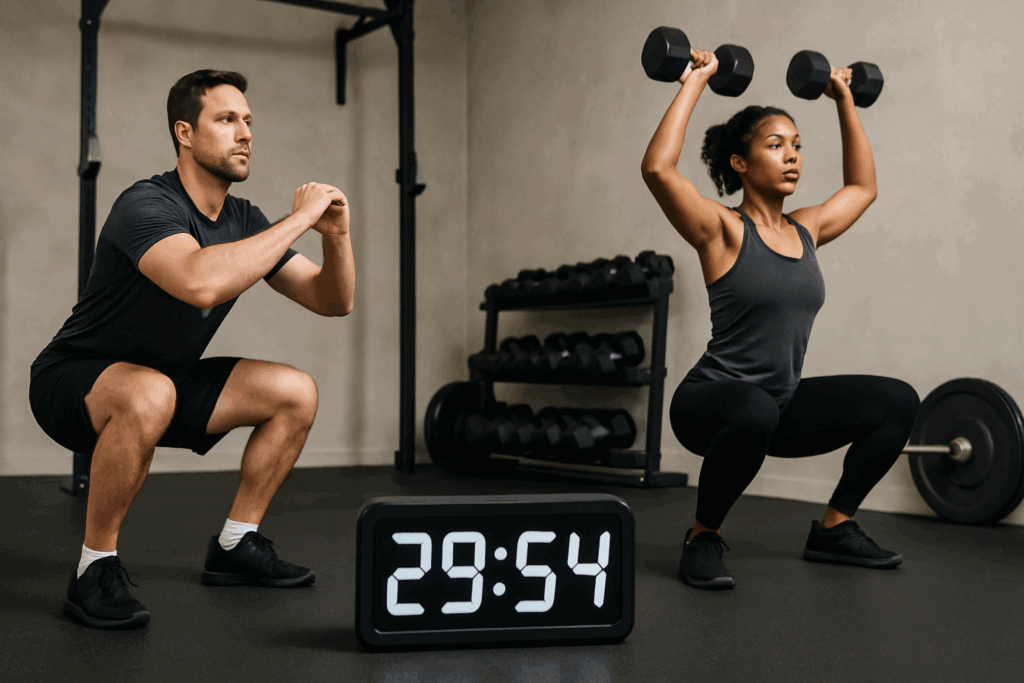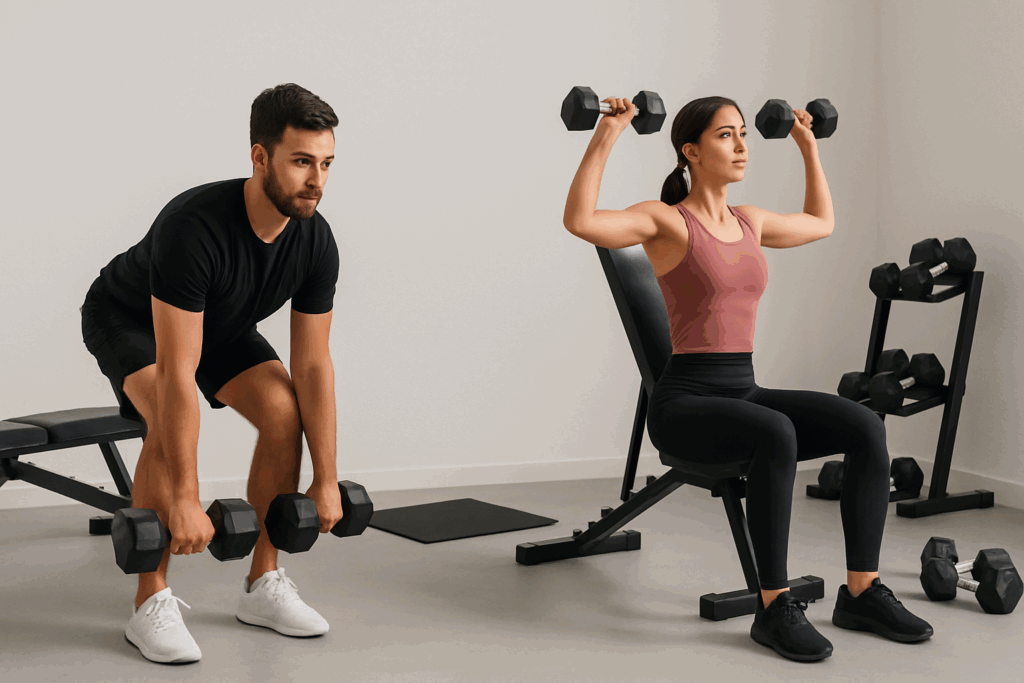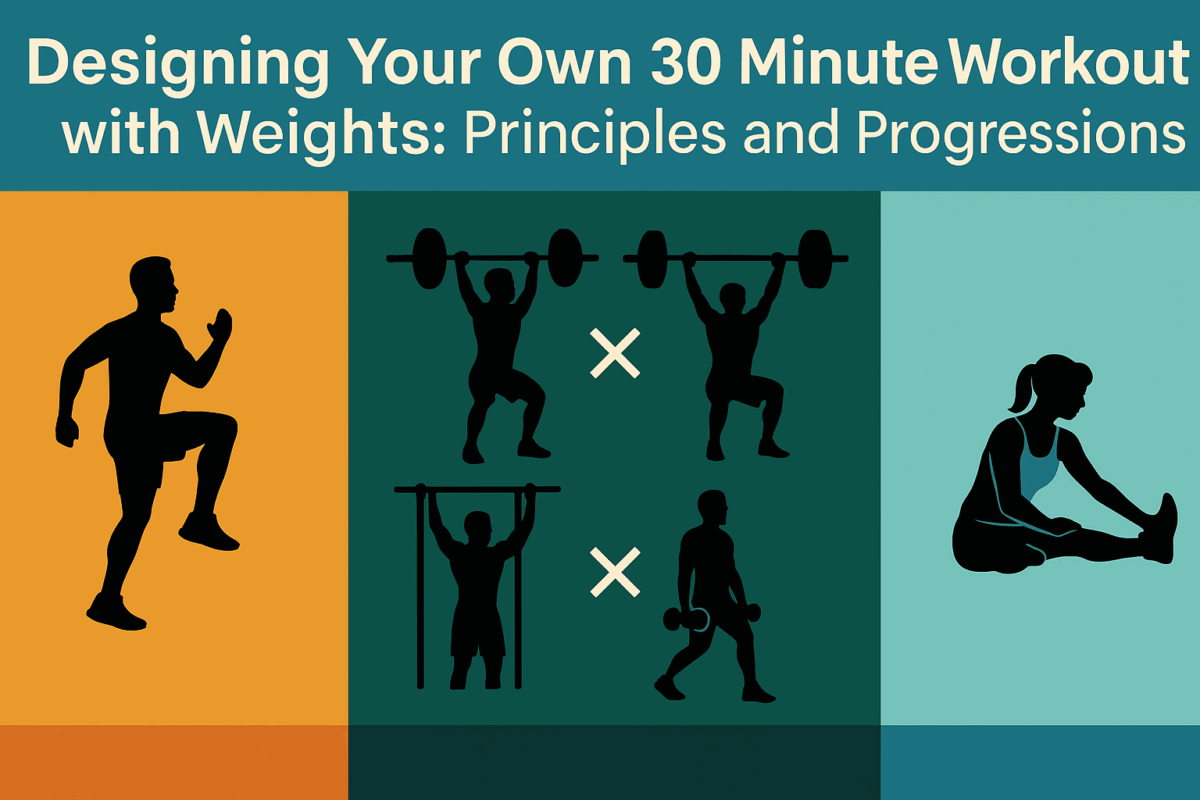Introduction: The Power of Time-Efficient Training
In a fast-paced world where time is a premium commodity, achieving meaningful fitness goals might seem like a luxury reserved for those with hours to spare. However, recent developments in exercise science and time-efficiency training strategies reveal a powerful truth: you don’t need to spend hours in the gym to gain muscle and build strength. A well-structured 30 minute workout with weights can deliver profound results when applied with intention, strategy, and consistency. This article explores the science, structure, and transformative benefits of such a program, showing how a short time commitment can yield robust, lasting improvements in both muscle development and overall fitness.
You may also like: The Ultimate Hypertrophy Workout Program for Building Strength and Size

Understanding the Science Behind Short-Duration Strength Workouts
The fundamental principle that drives muscle growth and strength development is progressive overload. This concept refers to consistently challenging your muscles with increasing resistance or intensity. While traditional wisdom once dictated long gym sessions, emerging research suggests that intensity and exercise selection matter more than duration. Studies in strength training literature have shown that time-efficient resistance training programs can stimulate hypertrophy and strength gains on par with longer routines, provided the exercises are performed with appropriate load, volume, and rest intervals.
When executed properly, a 30 minute strength training session can recruit significant muscle fiber activation, stimulate hormonal responses that support muscle growth (such as testosterone and growth hormone), and enhance neuromuscular coordination. Moreover, such sessions tend to promote higher adherence rates. People are more likely to stick to a 30 minute strength workout routine than an hour-long one, especially when managing tight schedules, family responsibilities, or professional commitments. Consistency, more than duration, determines long-term success.

Key Components of an Effective 30 Minute Strength Workout
A powerful 30 minute workout with weights should be crafted around compound movements, which work multiple muscle groups simultaneously. These exercises maximize muscle activation, calorie expenditure, and hormonal response. Classic compound lifts include squats, deadlifts, bench presses, overhead presses, and bent-over rows. These movements offer more bang for your buck and are ideal for time-constrained sessions.
Another key component is the integration of supersets or circuit-style training, which limits rest between exercises to maintain workout intensity and keep the heart rate elevated. By pairing exercises that target opposing muscle groups (like biceps and triceps, or quads and hamstrings), individuals can train more efficiently while reducing downtime. Rest periods, when carefully managed, not only support muscle endurance but also increase caloric burn.
Lastly, appropriate progression is crucial. This involves tracking reps, weights, and rest times to ensure continued challenge and adaptation. Utilizing periodization — varying the training focus in cycles — can help avoid plateaus and reduce injury risk. An intelligently designed 30 minute strength workout doesn’t just fit your schedule; it aligns with your long-term fitness trajectory.

Why a 30 Minute Full Body Dumbbell Workout Is Incredibly Effective
One of the most adaptable and accessible formats of this time-efficient approach is the 30 minute full body dumbbell workout. Dumbbells are ideal for home use, allow a full range of motion, and enable both unilateral and bilateral training. This helps address muscular imbalances, a common contributor to injury and suboptimal performance.
A full body approach means hitting all the major muscle groups — legs, back, chest, shoulders, and arms — in a single session. This not only promotes muscular symmetry and total-body strength but also boosts metabolic demand. A full body dumbbell workout performed three times a week can match or exceed the muscle-building outcomes of split routines that isolate different muscle groups on different days.
Furthermore, the functional nature of dumbbell movements mirrors real-life motions more closely than machine-based exercises. This improves coordination, stability, and joint integrity. By alternating between push and pull movements and incorporating lower-body and core-focused exercises, a 30 minute dumbbell workout delivers comprehensive training without requiring a full gym setup or extended time blocks.

Designing Your Own 30 Minute Workout with Weights: Principles and Progressions
To build your own effective 30 minute workout with weights, it’s essential to first identify your training objectives. Are you aiming to build mass, enhance strength, improve muscular endurance, or a blend of all three? Once goals are clarified, exercise selection and program structure can follow suit. A balanced routine might include three or four compound lifts interspersed with accessory movements targeting stabilizers and smaller muscle groups.
An example template might look like this: 5 minutes of dynamic warm-up, 20 minutes of strength training comprising 4 supersets, and 5 minutes of cooldown or mobility work. Within those supersets, you can include pairings such as deadlifts with push presses, squats with pull-ups, or rows with lunges. Keep rest intervals between sets to 30-60 seconds to sustain intensity while promoting muscular recovery.
Progressions should be built into your plan. This could mean increasing weights, performing more reps within the same time frame, reducing rest intervals, or advancing exercise difficulty (such as moving from a goblet squat to a front squat). Progress does not require complexity — it requires consistency, thoughtful programming, and listening to your body’s response.

Maximizing Hypertrophy in a 30 Minute Strength Workout
While strength and hypertrophy overlap, training for size requires attention to specific variables. In a 30 minute strength workout, hypertrophy can be optimized by targeting the 6-12 rep range, incorporating moderate to heavy resistance, and ensuring time under tension remains within the optimal growth window (approximately 30-60 seconds per set).
Techniques such as drop sets, tempo training, and mechanical tension strategies can be used to amplify the hypertrophic response. For instance, slowing down the eccentric phase (lowering portion) of a lift increases muscle damage and stimulates greater adaptation. Similarly, incorporating short bursts of high-rep burnout sets at the end of a workout can flood the muscles with blood and metabolites, which also contribute to growth.
Nutrition plays a vital role as well. Even the best 30 minute weight lifting workout won’t yield results without proper fueling. Consuming sufficient protein, managing caloric intake, and timing nutrients around workouts all influence recovery and muscle protein synthesis. For optimal hypertrophy, aim for 1.6-2.2 grams of protein per kilogram of body weight daily, with a post-workout meal or shake that includes both protein and carbohydrates to replenish glycogen and initiate recovery.

The Metabolic Benefits of a 30 Minute Full Body Weight Workout
Beyond aesthetics and strength, time-efficient workouts offer substantial metabolic and cardiovascular benefits. A 30 minute full body weight workout, especially one employing compound lifts and minimal rest, functions similarly to high-intensity interval training (HIIT). This elevates the heart rate, stimulates aerobic and anaerobic systems, and can improve cardiovascular health alongside muscular development.
Additionally, resistance training elevates post-exercise oxygen consumption (EPOC), commonly known as the afterburn effect. This means that your body continues burning calories at an elevated rate after your workout ends. The more muscle mass you activate during your session, the greater the EPOC response, making full-body sessions particularly effective.
This metabolic boost is especially valuable for those seeking fat loss or metabolic resilience. Combining strength training with nutritional strategies aimed at blood sugar regulation and hormone balance can result in long-lasting body composition improvements. And since shorter workouts are easier to adhere to over the long term, the cumulative metabolic effects become more pronounced with time.
Frequently Asked Questions: Advanced Strategies for Your 30 Minute Workout with Weights
1.How can I increase intensity during a 30 minute workout with weights without adding more weight?
Increasing intensity doesn’t always require heavier weights. One highly effective method is manipulating tempo — particularly slowing down the eccentric phase of each lift. This elongates time under tension and increases muscle fiber recruitment. Additionally, implementing advanced techniques such as supersets, drop sets, or rest-pause training can create metabolic stress and muscular fatigue within the 30 minute workout with weights framework. These methods challenge the muscles in new ways, fostering strength and hypertrophy while preserving workout duration.
2.Is a 30 minute dumbbell workout suitable for those focusing on rehabilitation or injury prevention?
Absolutely. A well-designed 30 minute dumbbell workout can be incredibly therapeutic for individuals recovering from injuries or focusing on injury prevention. Dumbbells allow for more natural movement patterns and greater joint freedom compared to machines or barbells, reducing stress on connective tissues. Exercises can be tailored to include unilateral work, helping to correct muscular imbalances that often lead to injury. Light to moderate loads paired with controlled form promote both stability and strength in vulnerable areas, making this a viable approach for post-rehab conditioning.
3.What are the best recovery strategies to complement a 30 minute strength workout?
Optimal recovery includes both immediate post-workout practices and long-term habits. After a 30 minute strength workout, prioritize rehydration and nutrient replenishment with a combination of high-quality protein and carbohydrates. Contrast therapy, such as alternating hot and cold showers, can reduce inflammation and promote circulation. Incorporating consistent sleep hygiene, mobility routines, and active rest days also facilitates faster recovery and adaptation. Additionally, wearing compression garments or engaging in guided breathwork can further enhance muscle repair and nervous system balance.
4.How do I periodize a 30 minute strength training routine for long-term progress?
To prevent plateaus, it’s essential to implement a periodized plan that evolves over time. Start with a foundation phase emphasizing movement quality and muscular endurance using moderate weights and higher reps. Transition to a hypertrophy phase with moderate to heavy loads in the 8-12 rep range. Follow this with a strength phase using heavier weights and lower reps, maintaining the 30 minute strength training format by adjusting rest and volume. Every 8-12 weeks, incorporate a deload week to allow physiological and psychological recovery. This structured approach ensures sustainable progression while minimizing injury risk.
5.How does the 30 minute full body dumbbell workout compare to machine-based routines in terms of neuromuscular engagement?
The 30 minute full body dumbbell workout provides superior neuromuscular engagement compared to machine-based training. Dumbbells require active stabilization and coordination across multiple joints, engaging both prime movers and synergist muscles. This not only enhances functional strength but also stimulates greater neural activation, improving motor control and muscle recruitment. Machine workouts often isolate movement planes and reduce the need for stabilization, which can limit long-term performance development. For individuals seeking dynamic and comprehensive strength improvements, dumbbells offer a more neurologically rich training environment.
6.Can a 30 min weight workout be combined with other modalities like yoga or cardio?
Yes, integrating a 30 min weight workout with yoga or cardio can create a balanced and holistic fitness regimen. Strength training enhances muscular endurance and power, while yoga improves flexibility, joint integrity, and stress resilience. Cardio can be added on alternating days or following weight sessions in the form of low-impact activities like walking, cycling, or rowing. For those pressed for time, hybrid sessions such as strength-yoga flows or circuit-style conditioning blends both resistance and cardiovascular training within a single, efficient workout. The key lies in aligning these modalities with your recovery capacity and specific goals.
7.Mental Benefits of a Consistent 30 Minute Workout with Weights Practice
Engaging regularly in a 30 minute workout with weights cultivates more than physical strength — it enhances mental resilience, focus, and emotional balance. Studies show that resistance training reduces symptoms of anxiety and depression by influencing neurotransmitters like serotonin and dopamine. Completing a focused session in a short window reinforces discipline and builds a positive feedback loop of achievement. The predictability and structure of a brief but effective workout routine offer psychological grounding in the midst of busy lifestyles. Over time, this commitment strengthens self-efficacy, empowering individuals to meet challenges inside and outside the gym.
8.How can I maintain progression using only a 30 minute weight lifting workout format?
Progression within a 30 minute weight lifting workout can be achieved by manipulating training variables rather than extending time. Increasing load, reducing rest intervals, introducing advanced exercise variations, or altering rep schemes are all effective strategies. For example, progressing from goblet squats to Bulgarian split squats adds complexity and intensity without requiring longer sessions. Using pyramid sets or cluster training keeps sessions stimulating while promoting adaptation. Keeping detailed logs of each session enables strategic tweaks and ensures that progress is intentional and measurable.
9.What nutritional approaches best support a 30 minute full body weight workout routine?
Supporting a 30 minute full body weight workout with appropriate nutrition enhances performance and accelerates recovery. Pre-workout meals should include easily digestible carbs and lean protein, such as a banana with Greek yogurt or a small oatmeal bowl with whey protein. Post-workout, aim to replenish glycogen stores with complex carbohydrates and consume 20-30 grams of high-quality protein within 30 minutes. Hydration is equally crucial; consider adding electrolytes if sweating heavily. Long-term dietary habits should emphasize whole foods rich in micronutrients, omega-3s, and fiber to support inflammation control, muscle repair, and metabolic health.
10.How can I tailor a 30 minute strength workout for performance in specific sports?
To align a 30 minute strength workout with sports-specific goals, begin by identifying key movement patterns and energy systems required by the sport. For instance, a tennis player might prioritize rotational strength, lateral agility, and grip endurance, whereas a sprinter needs explosive hip extension and posterior chain development. Incorporate plyometrics, unilateral exercises, and sport-replicating movement sequences within the 30 minute strength workout framework. Periodize workouts around competition schedules to balance volume and recovery. Customizing your short-duration sessions with specificity in mind creates targeted adaptations that translate directly to athletic performance.
Conclusion: Building Muscle and Strength with a 30 Minute Workout with Weights
Time-efficient strength training programs are more than just a trend — they represent a paradigm shift in how we approach fitness. By leveraging the physiological benefits of compound movements, progressive overload, and structured routines, a 30 minute workout with weights can deliver powerful and lasting results. Whether your goal is to build muscle, enhance strength, or improve overall fitness, this streamlined approach allows you to integrate training into your lifestyle without sacrificing effectiveness.
As we’ve explored, strategies such as full-body dumbbell workouts, hypertrophy-focused programming, and metabolic conditioning all play crucial roles in the success of short-duration routines. With intelligent planning, proper nutrition, and consistency, these compact sessions become a foundation for lifelong health and performance. Embracing the efficiency of a 30 minute strength training plan not only saves time but also reinforces the principle that smart training is more impactful than long training. Choose precision, dedication, and focus — and let the results speak for themselves.
Further Reading:
This 30-Minute Dumbbell Workout Does It All





